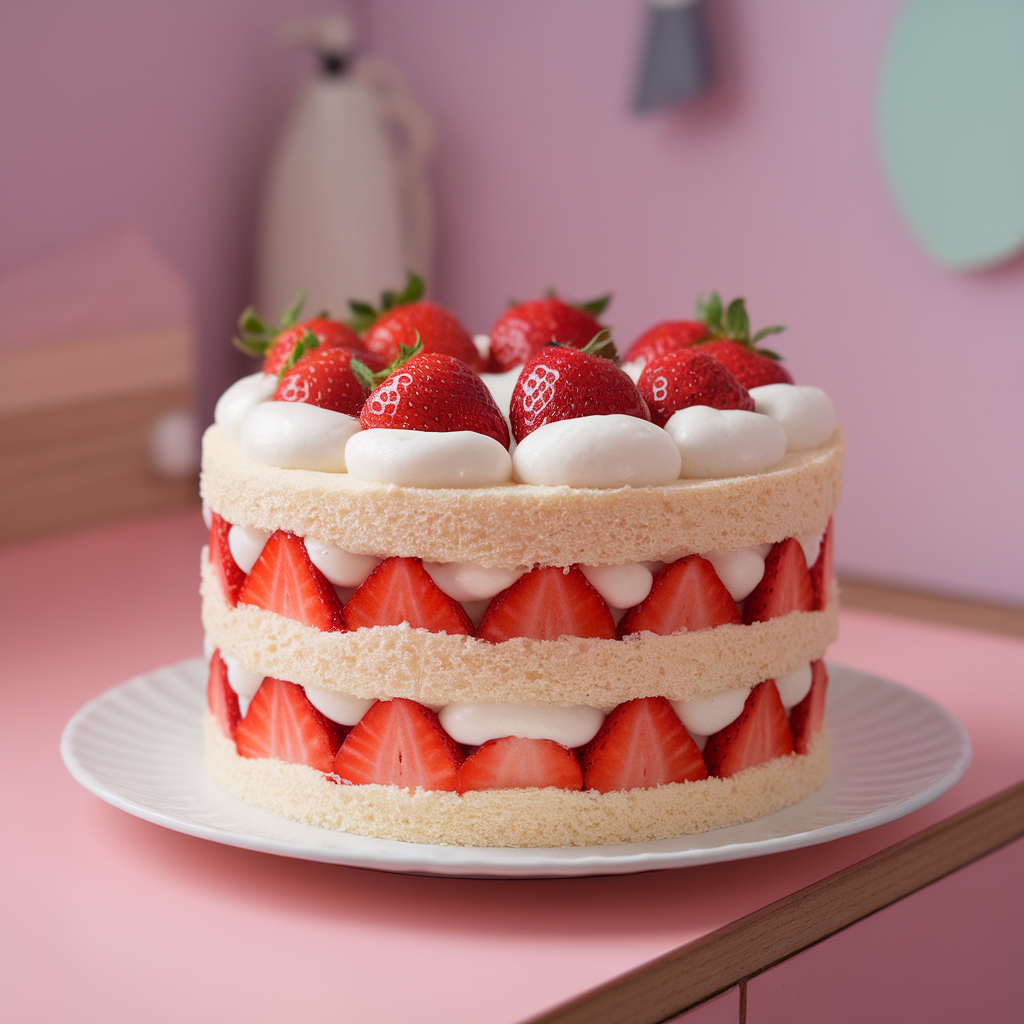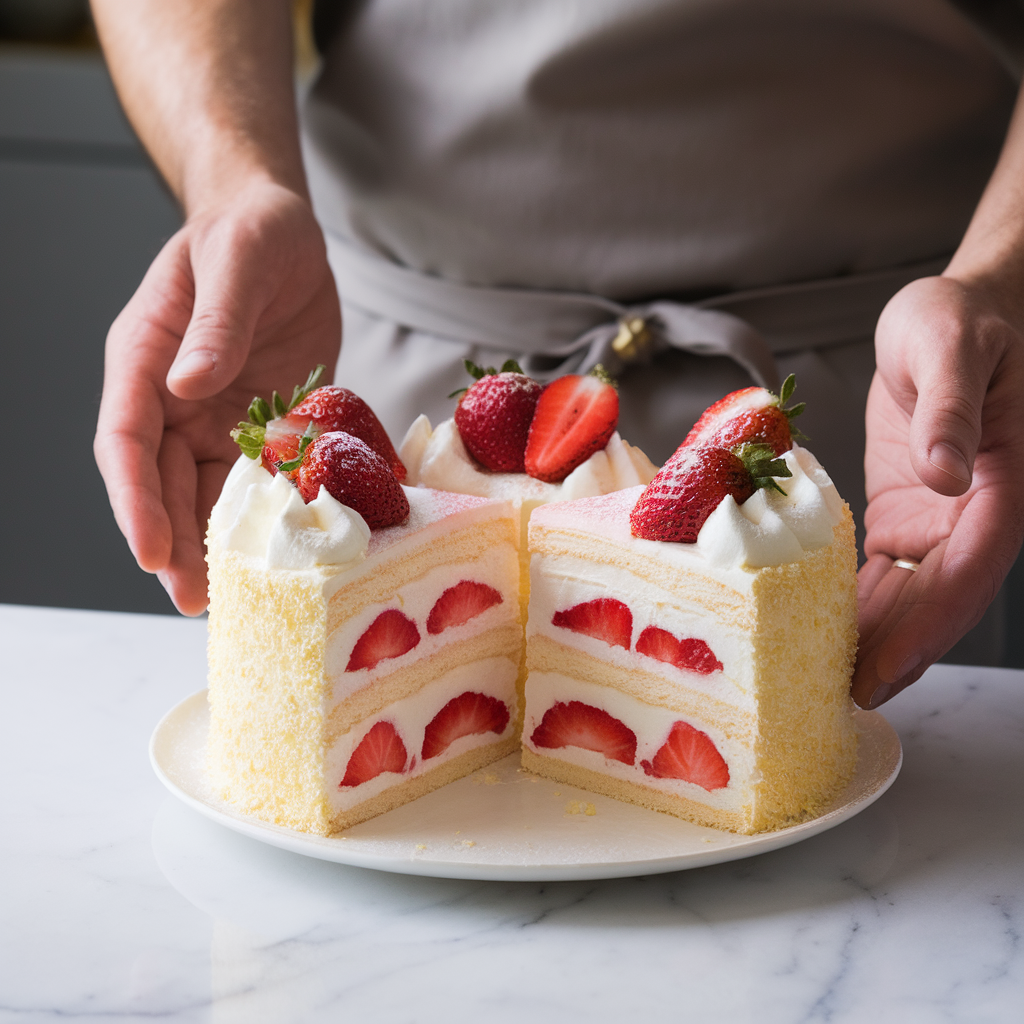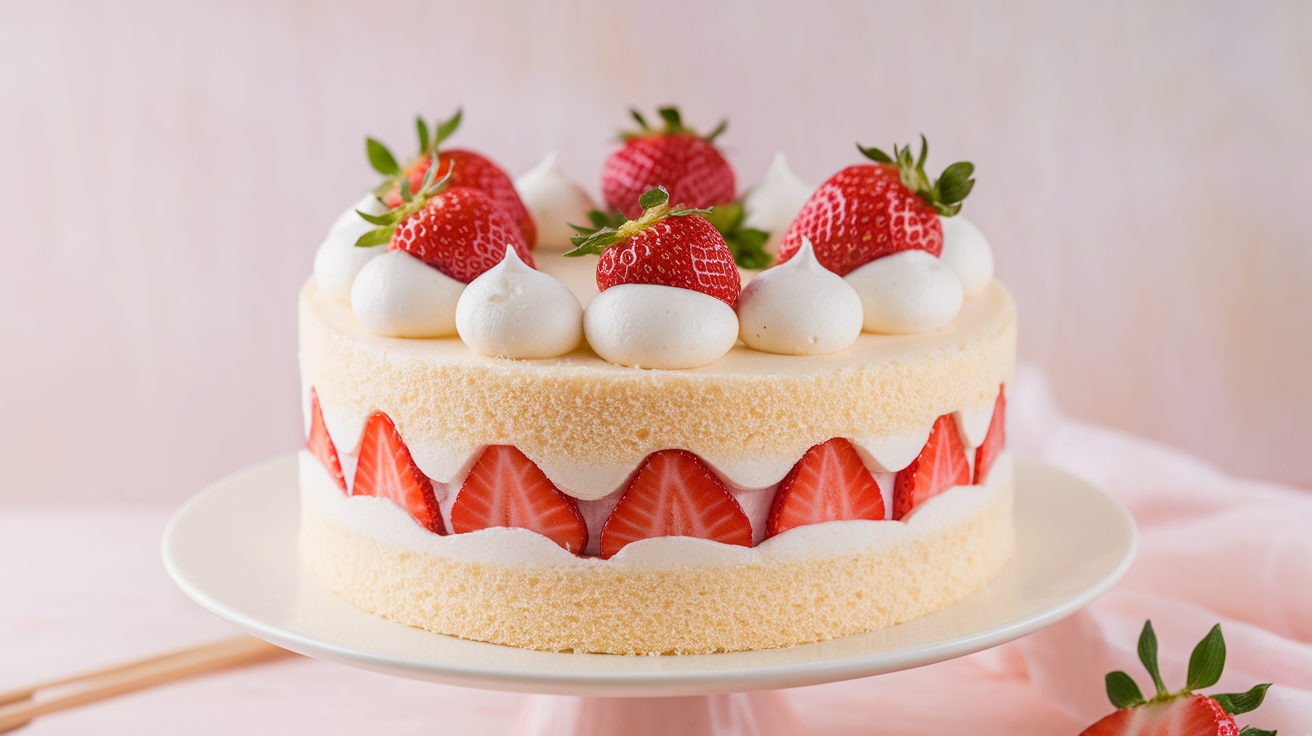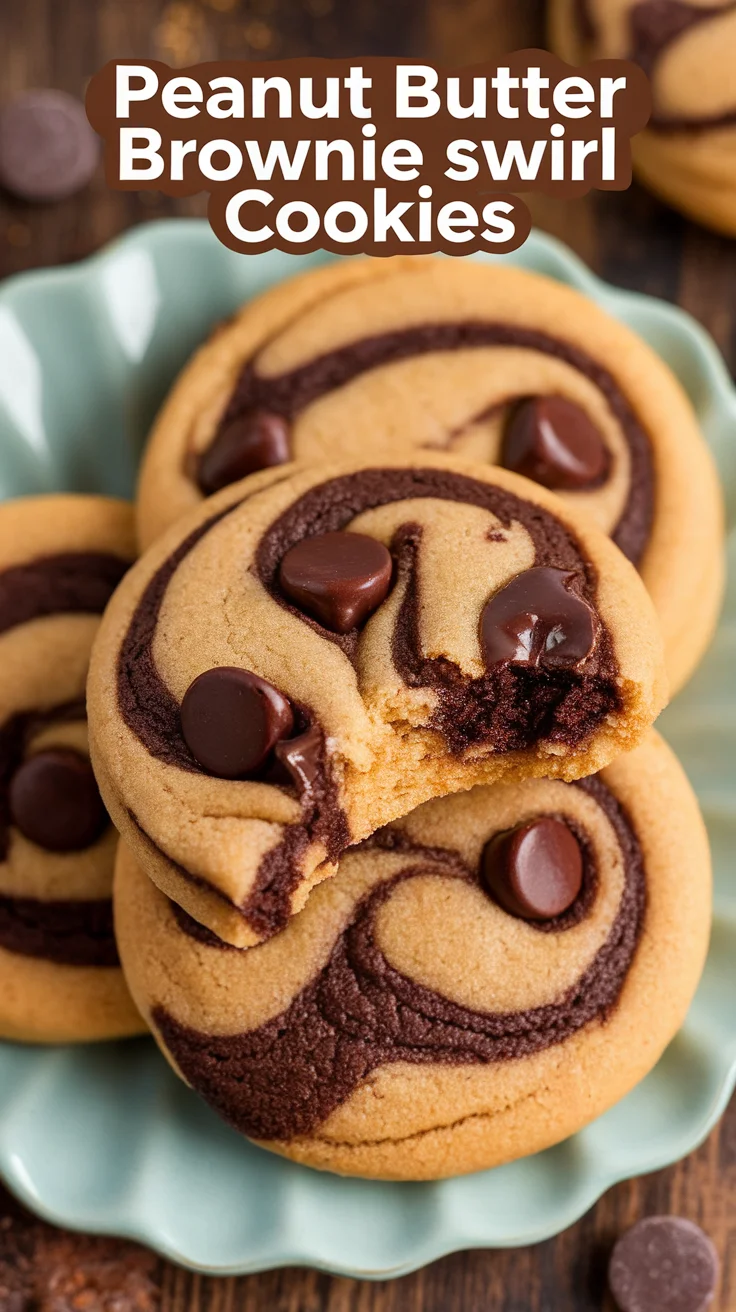When it comes to elegant, delicate, and irresistibly light desserts, the Japanese Strawberry Sponge Cake — often called the Japanese Strawberry Shortcake — stands out as a shining star in the world of Japanese cakes. Celebrated across Japan and gaining rapid popularity worldwide, this dessert perfectly embodies the principles of Japanese baking: simplicity, balance, and the artful use of fresh ingredients.
If you’re searching for an authentic, show-stopping Japanese recipes dessert to create at home, this recipe for a fluffy, moist Japanese sponge cake layered with luscious whipped cream and fresh strawberries will not disappoint. From its ethereal texture to the harmonious blend of flavors, this cake offers a truly memorable eating experience.
In this comprehensive guide, we’ll explore every aspect of this iconic cake — from the science behind the signature fluffiness, the precise ingredients and techniques, to detailed assembly and decoration tips. Along the way, you’ll discover how to master a perfect fluffy sponge cake, create a stunning strawberry layer cake, and impress everyone with your skills in the art of the Japanese strawberry shortcake recipe.
What Is Japanese Strawberry Sponge Cake? Understanding the Classic Dessert
Unlike heavier Western-style cakes that often rely on buttercreams and dense batters, the Japanese strawberry sponge cake is renowned for its light, airy crumb and subtle sweetness. The cake itself is a delicate sponge that melts in your mouth, made by carefully whipping eggs and folding in ingredients to trap as much air as possible.
The cake layers are sandwiched with lightly sweetened whipped cream and fresh strawberries — the star fruit of this dessert. This combination creates a refreshing balance of textures and flavors: soft, spongy cake; creamy, silky whipped cream; and the bright, juicy tartness of strawberries.
Commonly served during birthdays, Christmas celebrations, and spring festivals in Japan, this dessert embodies the Japanese culinary philosophy that celebrates fresh, seasonal ingredients and aesthetic simplicity. The cake’s minimalistic decoration, usually just cream and strawberries arranged gracefully on top, echoes this sensibility.
Why This Japanese Fluffy Cake Recipe Is Special
1. The Texture: Fluffy and Airy but Moist
The hallmark of any great Japanese sponge cake is its texture. Unlike traditional sponge cakes, which can be dense or dry, this cake’s crumb is remarkably soft and moist. Achieving this texture requires precise technique — primarily the method of whipping egg whites to create a stable meringue and folding it gently into the batter without deflating it.
2. Balanced Sweetness
The sponge itself is only mildly sweet, allowing the fresh strawberries and lightly sweetened cream to shine. This balanced sweetness makes the cake feel light rather than heavy or overly sugary.
3. Freshness and Simplicity
Using fresh strawberries as the main fruit ingredient is essential. The natural tartness and juiciness complement the whipped cream and sponge, creating a harmony of flavors. The simplicity of the cake also allows you to appreciate the quality of the ingredients fully.
4. Elegant Presentation
The beauty of a Japanese strawberry shortcake lies in its understated elegance. A smooth, white whipped cream exterior dotted with red strawberries makes for a stunning and inviting dessert.

Ingredients: Building Blocks of the Perfect Japanese Strawberry Shortcake
The secret to this cake’s success lies in using quality ingredients and balancing them perfectly. Here is what you’ll need:
For the Fluffy Sponge Cake:
- 4 large eggs (preferably room temperature, to ensure proper aeration)
- 120 grams (about 1 cup) granulated sugar (divided)
- 100 grams (¾ cup plus 2 tbsp) cake flour, sifted (cake flour is essential for tenderness)
- 30 ml (2 tbsp) whole milk (room temperature, to keep the batter moist)
- 30 grams (2 tbsp) unsalted butter, melted and cooled (adds richness)
- 1 teaspoon pure vanilla extract (for subtle aroma)
- A pinch of salt (balances sweetness and enhances flavor)
For the Strawberry Cream Filling:
- 300 ml (1¼ cups) heavy whipping cream, cold (high quality for better texture)
- 30 grams (2 tbsp) powdered sugar (adjust to taste)
- 1 teaspoon vanilla extract
- About 400 grams (14 oz) fresh strawberries, washed, hulled, and sliced (plus some whole or halved for decoration)
Detailed Instructions for Making the Fluffy Sponge Cake
Step 1: Prepare the Baking Pans and Oven
- Preheat your oven to 170°C (338°F).
- Prepare two 7-inch (18 cm) round cake pans by lightly greasing and lining the bottom with parchment paper.
- Sift your cake flour at least twice for a fine, lump-free texture.
Step 2: Separate the Eggs
- Carefully separate the egg whites and yolks into two clean bowls.
- Ensure no yolk contaminates the whites — even a small amount of fat can prevent the whites from whipping properly.
Step 3: Make the Meringue
- Using an electric mixer on medium speed, begin beating the egg whites until foamy.
- Gradually add half of the sugar (about 60 grams), continuing to whip until soft peaks form.
- Add the remaining sugar and whip until stiff, glossy peaks form — this means the peaks stand up firmly and don’t droop when the whisk is lifted.
Step 4: Mix Egg Yolks with Wet Ingredients
- In the yolk bowl, whisk the egg yolks with the remaining sugar until the mixture becomes pale and slightly thickened.
- Add the milk, melted butter, and vanilla extract, mixing gently until combined.
Step 5: Combine Dry and Wet Ingredients
- Sift the cake flour and salt into the yolk mixture.
- Fold the flour gently with a spatula until just combined — do not overmix or you’ll deflate the batter.
Step 6: Incorporate the Meringue
- Add about one-third of the meringue to the yolk batter to lighten it.
- Gently fold in the rest of the meringue carefully, using a spatula to scoop from the bottom and fold over the top, preserving as much air as possible.
Step 7: Bake the Cake
- Divide the batter evenly between the two pans.
- Tap the pans lightly on the countertop to remove large air bubbles.
- Bake for 20–25 minutes, or until a toothpick inserted in the center comes out clean.
- The cake should spring back when lightly pressed.
Step 8: Cool Completely
- Remove the cakes from the oven.
- Let them cool in their pans for 10 minutes before turning out onto wire racks to cool completely.
- Do not frost or assemble until completely cool to prevent cream melting.

How to Prepare the Strawberry Cream Filling
Step 1: Chill Equipment
- Place a mixing bowl and whisk attachment in the refrigerator for at least 10 minutes — cold equipment helps the cream whip better.
Step 2: Whip the Cream
- Pour cold heavy cream into the chilled bowl.
- Add powdered sugar and vanilla extract.
- Whip on medium-high speed until soft peaks form — when you lift the whisk, peaks should hold shape but slightly droop.
- Avoid over-whipping, or the cream will turn grainy and begin to separate.
Step 3: Prepare Strawberries
- Slice the washed and hulled strawberries.
- Reserve some whole or halved berries for decoration.
Assembling the Japanese Strawberry Layer Cake
Step 1: Level the Cakes
- Use a serrated knife to trim off any domed tops to create flat, even layers.
Step 2: Add Cream and Strawberries
- Place one cake layer on a serving plate.
- Spread a generous layer of whipped cream evenly over the surface.
- Arrange sliced strawberries over the cream.
Step 3: Stack and Repeat
- Place the second cake layer gently on top.
- Apply a thin crumb coat of whipped cream all over the cake.
- Refrigerate for 15–30 minutes to let the crumb coat set.
Step 4: Final Frosting and Decoration
- Add a thick, smooth final layer of whipped cream.
- Decorate with whole or halved strawberries on top in a pleasing pattern.
- Optionally, garnish with mint leaves or edible flowers.
Expert Tips for Baking the Best Japanese Fluffy Cake
- Use room temperature eggs to maximize volume when whipping.
- Handle the batter gently — folding technique is key to keeping the sponge airy.
- Sift your flour multiple times to ensure a light, lump-free batter.
- Avoid opening the oven door during baking to prevent the cake from collapsing.
- Use cake flour instead of all-purpose flour for a tender crumb.
- Keep the cream cold and whip it just until soft peaks form.
- Refrigerate the cake after assembly to let flavors meld and the cream set.
Variations to Explore Beyond the Classic
- Matcha Strawberry Sponge Cake: Add 1–2 teaspoons of matcha powder to the flour for a subtle green tea flavor that pairs beautifully with strawberries.
- Mixed Berry Shortcake: Incorporate blueberries, raspberries, or blackberries for a multi-berry version.
- Chocolate Japanese Sponge Cake: Add cocoa powder to part of the batter to create a marbled effect.
- Mango or Peach Layers: Substitute strawberries with sliced mango or peaches for a tropical twist.
- Vegan Version: Use aquafaba (chickpea liquid) as an egg white substitute and coconut cream for the filling.

The Cultural Significance of Japanese Strawberry Shortcake
This cake is not just a dessert — it’s part of Japanese holiday traditions. It’s especially popular at Christmas, where families gather around to share a beautifully decorated strawberry shortcake. The cake symbolizes purity and seasonal celebration.
Its gentle sweetness and focus on fresh fruit make it different from Western cakes, which tend to be richer or heavily frosted. It’s also widely enjoyed during strawberry harvest season in spring, showcasing Japan’s respect for fresh, seasonal ingredients.
Serving Suggestions and Pairings
Serve your Japanese strawberry sponge cake with:
- A light green tea or jasmine tea to complement the delicate sweetness.
- A fresh fruit salad on the side for extra natural sweetness.
- A scoop of vanilla bean ice cream for a richer dessert option.
- For special occasions, accompany it with a glass of sparkling sake or champagne.
Troubleshooting Common Challenges
- Cake collapses: Likely from overmixing or opening the oven door early. Fold batter gently and avoid opening the oven.
- Dense cake: Underwhipped meringue or overmixing batter can weigh it down. Whip whites to stiff peaks and fold carefully.
- Cream too soft or runny: Whip cream longer, but watch closely to avoid turning into butter.
- Strawberries bleed color into cream: Use very fresh, firm strawberries and pat dry before slicing.
Frequently Asked Questions (FAQs)
What is the difference between Japanese strawberry shortcake and Western strawberry shortcake?
Japanese strawberry shortcake uses light, fluffy sponge and whipped cream, while Western versions often use biscuit-like cakes and sometimes denser cream or custards.
Can I use frozen strawberries?
Fresh strawberries are preferred for texture and flavor. Frozen can be used if thawed and drained well, but they tend to release water and soften the cake.
How do I store leftovers?
Store covered in the refrigerator and consume within 2 days for best freshness.
Can I freeze the assembled cake?
Freezing is not recommended as whipped cream texture and strawberry freshness degrade upon thawing.
Nutritional Information (Approximate per serving, 1/8th cake)
- Calories: 270 kcal
- Protein: 5 grams
- Carbohydrates: 30 grams
- Fat: 13 grams
- Sugars: 20 grams
Final Thoughts: Elevate Your Baking With This Japanese Classic
The Japanese Strawberry Sponge Cake is much more than a dessert; it’s an experience — combining artistry, tradition, and the joy of sharing simple pleasures. Mastering this cake means you’ve conquered one of the most iconic Japanese cakes celebrated for its fluffy sponge cake texture and luscious fruit and cream layers.
Whether you’re baking for a birthday, a seasonal celebration, or just because, this recipe will bring smiles and delight to any table. It represents the best of Japanese recipes dessert culture — light, fresh, balanced, and elegant.
So gather your ingredients, prep your kitchen, and embark on a baking adventure that yields a heavenly strawberry cream sponge cake that’s sure to impress.


